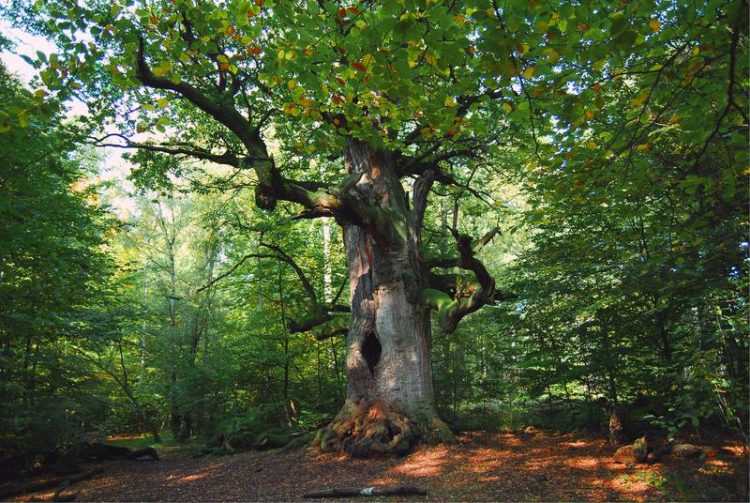Older and more diverse forests are more stable in taking up carbon dioxide

Old forest in Hessen, Germany Achim Lueckemeyer / pixelio, www.pixelio.de
The total uptake of carbon dioxide by ecosystems via photosynthesis is the largest flux in the global carbon cycle. The intensity of this “natural CO₂ pump” shapes the atmospheric concentrations of the greenhouse gas. However, this key process is influenced by climate variability, which translates into year-to-year variations of CO₂ taken up by forests.
“Understanding the causes of the year-to-year variations in photosynthetic CO₂ uptake improves our understanding of the global carbon cycle and its sensitivity to climate”, says Markus Reichstein, co-author and Director at Max Planck Institute for Biogeochemistry in Jena, Germany.
In a search for environmental factors that determine the amplitude of the year-to-year variability in the photosynthetic capacity of forests, an international research team led by Talie Musavi of the same institute compiled data from 50 globally distributed forests across different climatic regions.
The scientists combined a variety of different data sources including ecosystem-atmosphere CO₂ fluxes from a global network of measurement sites, climate data, biodiversity information, nutrient availability, forest age, and other properties derived from satellite data, such as forest height and tree cover. The scientists then tried to identify the main factors that buffer the annual variations of photosynthetic capacity.
“The year to year variability is driven by climate but the magnitude of the year to year variability decreases in older and more diverse forests. We conclude that the stability of photosynthetic capacity is mostly controlled by forest age and species richness”, says Talie Musavi. This finding can be read as a scientific call to preserving old forests and their diversity in order to stabilize their functionality.
The study belongs to a series of activities emerging from the European project BACI “Biosphere-Atmosphere Change Index”, an international project funded in the context of EU’s Horizon2020 program. “Our project in particular aims at integrating remote sensing data archives, but also a wide range of biodiversity data, and long-term observations of ecosystem functioning.” explains Miguel Mahecha who coordinates the project at the Max Planck Institute for Biogeochemistry. BACI is developing methods and seeks to foster research into better understanding how our ecosystems interact with the atmosphere.
Original publication
Talie Musavi, Mirco Migliavacca, Markus Reichstein, Jens Kattge, Christian Wirth, T. Andrew Black, Ivan Janssens, Alexander Knohl, Denis Loustau, Olivier Roupsard, Andrej Varlagin, Serge Rambal, Alessandro Cescatti, Damiano Gianelle, Hiroaki Kondo, Rijan Tamrakar and Miguel D. Mahecha. (2017). Stand age and species richness dampen interannual variation of ecosystem-level photosyn-thetic capacity. Nature Ecology & Evolution.
http://dx.doi.org/10.1038/s41559-016-0048
BACI project reference:
http://baci-h2020.eu/index.php/
Contact
Talie Musavi
Email: tmusavi@bgc-jena.mpg.de
Mirco Migliavacca
Phone: +49 (0)3641 57 6281
Email: mmiglia@bgc-jena.mpg.de
Miguel Mahecha
Phone: +49 (0)3641 57 6265
Email: mmahecha@bgc-jena.mpg.de
Institutions that participated in the study
German Centre for Integrative Biodiversity Research (iDiv) Halle-Jena-Leipzig, Leipzig, Germany
Institute of Special Botany and Functional Biodiversity, University of Leipzig, 04103 Leipzig, Germany
Biometeorology and Soil Physics Group, Faculty of Land and Food Systems, University of British Columbia, 2329 West Mall, Vancouver, British Columbia, Canada
University of Antwerpen, Department of Biology, 2610 Wilrijk, Belgium
Bioclimatology, Georg-August University of Göttingen, 37077 Göttingen, Germany
INRA, ISPA, Centre de Bordeaux Aquitaine, 71 Avenue Edouard Bourlaux, 33140 Villenave-d’Ornon, France.
UMR Ecologie Fonctionnelle and Biogéochimie des Sols et Agroécosystèmes, SupAgro-CIRAD-INRA-IRD, Montpellier, France
A.N. Severtsov Institute of Ecology and Evolution, Russian Academy of Sciences, Moscow, 119071, Russia
Centre d'Ecologie Fonctionnelle et Evolutive, CEFE, UMR 5175, CNRS, Montpellier, France
Universidade Federal de Lavras, Lavras, MG, 37200-000, Brazil
European Commission, Joint Research Centre, Directorate for Sustainable Resources, 21027, Ispra, Italy
Department of Sustainable Agro-Ecosystems and Bioresources, Research and Innovation Center, Fondazione Edmund Mach, 38010 San Michele all’ Adige Trento, Italy
Foxlab Joint CNR-FEM Initiative, Via E. Mach 1, 38010 San Michele all'Adige, Italy
National Institute of Advanced Industrial Science and Technology (AIST), Onogawa, Tsukuba, Ibaraki, 305-8561, Japan
http://dx.doi.org/10.1038/s41559-016-0048 Original publication
http://baci-h2020.eu/index.php/ BACI project webpage
Media Contact
All latest news from the category: Earth Sciences
Earth Sciences (also referred to as Geosciences), which deals with basic issues surrounding our planet, plays a vital role in the area of energy and raw materials supply.
Earth Sciences comprises subjects such as geology, geography, geological informatics, paleontology, mineralogy, petrography, crystallography, geophysics, geodesy, glaciology, cartography, photogrammetry, meteorology and seismology, early-warning systems, earthquake research and polar research.
Newest articles

First-of-its-kind study uses remote sensing to monitor plastic debris in rivers and lakes
Remote sensing creates a cost-effective solution to monitoring plastic pollution. A first-of-its-kind study from researchers at the University of Minnesota Twin Cities shows how remote sensing can help monitor and…

Laser-based artificial neuron mimics nerve cell functions at lightning speed
With a processing speed a billion times faster than nature, chip-based laser neuron could help advance AI tasks such as pattern recognition and sequence prediction. Researchers have developed a laser-based…

Optimising the processing of plastic waste
Just one look in the yellow bin reveals a colourful jumble of different types of plastic. However, the purer and more uniform plastic waste is, the easier it is to…



